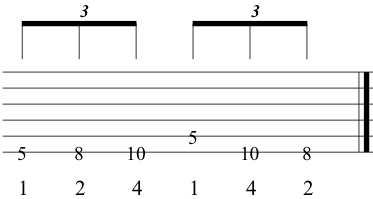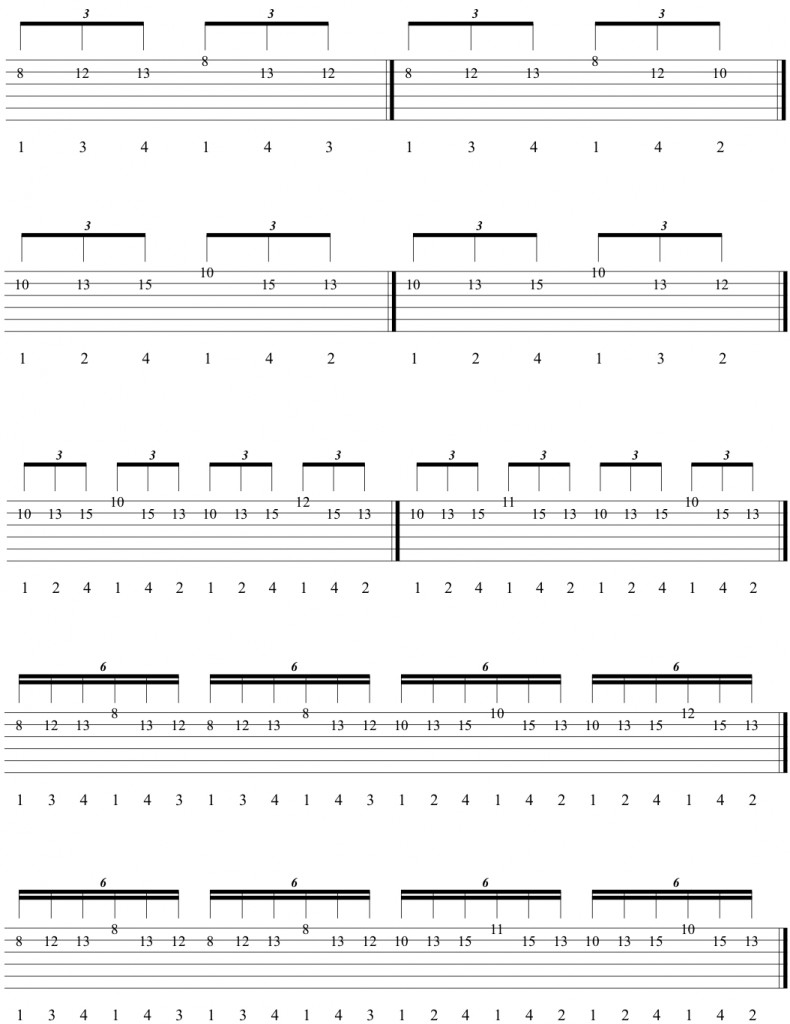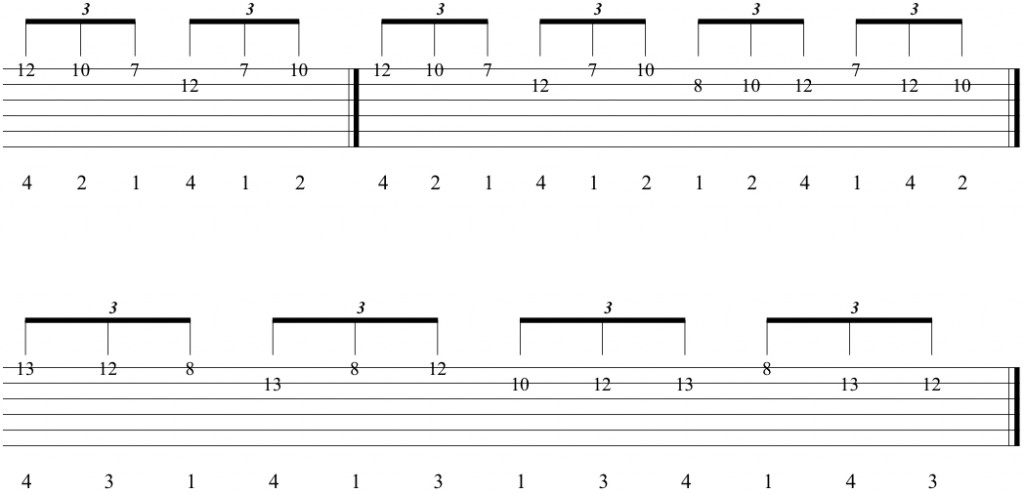Fast Lines With Notes Repeating Over Different Strings
When you speed pick melody lines where notes are repeated on different strings, the aural illusion gets created that there are more notes being played than is the case.
Like in following examples:

I the above example: the melody notes are A C D D D C, with the 1st D note played on the low E string, the 2nd D note on the A string, and the last D note played on the low E string again. This confuses the ear a bit, which makes those lines sonically all the more interesting.
The numbers underneath the tablature staff show which fingers to use.
The reason for this “ear-confusion” is that the difference in timbre between for example a B note played on the G string and that same B note on the D string, is different enough to make it “unclear” to the ear that a note is being repeated.
So the ear kind of hears that the note is the same, but gets confused at high speed by the timbre difference between the different versions of that same note being played on different strings.
You can hear those kinds of fast lines in the solos of Guthrie Govan, Shawn Lane, and many fusion guitarists.
Those kinds of speed exercises are a little more advanced and more challenging, because these melody lines with notes doubled over different strings, contain wider stretches.
Here’s another more elaborate example, which starts off like the above example, then moves up the 4th interval from the E to the A string, repeating the same melodic sequence on the A string.

Here are lots of ascending examples on the top strings.
Every bar is 1 technique exercise that you want to loop. All examples are ascending melodic phrases.

All the above examples are in triplets and sextuplets. Of course, you could also make lines with 16th notes.
All of the examples so far were ascending melodic patterns.
You could of course also use this note repetition idea in descending melodic phrases, as in the following 3 examples.
The B note is played on the 7th fret of the high E string, followed by a B on the 12th fret of the B string, followed by the previous B note again on the high E string.
Or you could have ascending-descending combinations.
In the 2nd example: it starts of with a 6-note melodic pattern descending in triplets, followed by a 6-note ascending melodic phrase in triplets.

The 3rd example uses the same idea as example 2 but starts on an F note instead of on E. This trains and works different finger muscles in the fretting hand.
As an added exercise: you could loop example 2 and example 3 back to back, played in rapid succession for a scalar line.
Example 2 starts on E, the next example starts on F: you could start on G next and move all the notes of example 3 up to the next note in the scale. (The 3 above examples are in the key of C).
You could then connect the 3 melodic patterns (starting from E, then from F, and then from G) into longer scalar lines.
Figure out the fingering starting from A, then from B, from C, and so on: till you have all 7 fingerings figured out in the key of C.
Then you could play them all in series for long intricate, cool-sounding improv lines.
Move it to different string sets, practice it in different keys, etc…
The sky is the limit really.
More importantly: your bag of guitar tricks got a little richer again with this melodic and improvisation technique that is unique to guitar.
Once you get this soloing technique down, you got yourself to stand out yet a little more again from the crowd of guitarists.
In addition: this is also a fun and very musical way to practice and improve your coordination, speed, dexterity, and control.
Before I close, let me give you 3 more picking exercises (not related to the above topic btw)
The only similarity to the above topic is that you still have the wider stretches.
Somehow: the next 2 examples are actually even cooler sounding than the above note repetition examples.
As it goes: because of the difference in tuning between the G and B strings (compared to the tuning of all the other strings on a guitar), you can come up with really quirky lines that are confusing to the ear.
In the next example: the notes are C Eb F E F Eb
All notes except for the E note are played on the G string. The E is played on the B string.
This confuses the ear (and for many guitar students also their fingers): as we are programmed to hear a higher note when we go to a higher string.
In this particular example, however: it goes from F on the G string to the lower E note (a half step down from F) played on the higher B string.
The melodic interplay between the 3 chromatic notes Eb, E and F played on 2 different strings, creates unusual melodic textures.

The 2nd example builds further on the 1st one, but with the higher melodic note alternating between E and Gb/F# with every repetition of the phrase.
And then one more exercise before closing. Something entirely different: no connection to any of the above.
This is just a simple, fun 3-note chromatic pattern for you to have fun with.

There’s a lot you can do with the above 16 exercises.
Have fun being creative, and further developing your technical proficiency on the guitar.
If you want to revisit last week’s technique blog (which this one here was an extension of), you can do so HERE
Keep Rocking!!!
Conclusion
Hit me up anytime at vreny@zotzinmusic.com if you have any questions, or if you would like to book a lesson.
These free lessons are cool, but you will never experience the progress, joy, and results that my students experience in lessons when you’re learning by yourself from blogs and videos.
That is why people take lessons: way better results and progress, much more complete information, exposed to way more creative ideas than you can get from a blog or YouTube video.
There is only so much that self-study can accomplish.
If you want to see amazing results and progress in your guitar playing, buy your first lesson here and get started ASAP.
You’ll impress your friends and loved ones in no time with your guitar playing!
Consider donating any small amount to help me keep this blog going.
Thank you for your support!


